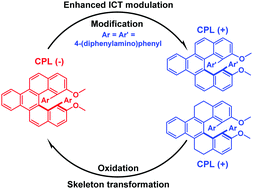Sign inversions of circularly polarized luminescence for helical compounds by chemically fine-tuning operations†
Abstract
Sign inversions of circularly polarized luminescence (CPL) for the hydro[5]helicene and [5]helicene derivatives were discovered and studied experimentally and theoretically. The inverted CPL signs from the hydro[5]helicene to [5]helicene derivatives were realized by one-step oxidation. The introduction of triphenylamine (TPA) subunits into the helical skeletons also led to the sign inversion of CPL only when there existed an enhanced intramolecular charge-transfer state with a small enough Egap.



 Please wait while we load your content...
Please wait while we load your content...